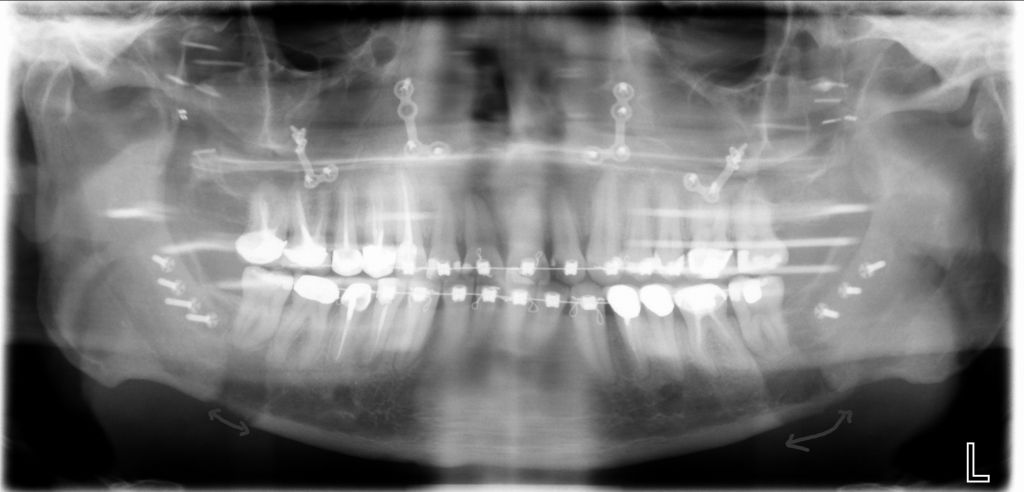I got a few Xrays, so I thought I'd post them. The last one is the most interesting since it's post procedure. The interesting part is how far Dr Li was able to move my bottom jaw (15 to 20mm) and the fact that left and right were not moved the same amount because my jaw and bite have always been sideways, and he had to move one side more than the other to correct that.
The X-Rays also shows that the back teeth were moved a bit forward compared to the front, but the entire jaw was moved a lot more than just the offset change between top and bottom, as the front jaw was moved forward too (just less than the bottom since moving it too much would not be aesthetically pleasing).

does show that my upper teeth were way in front of the bottom ones (not because of the teeth as much as the jaw).

before

after (check the arrows showing where and by how much the bottom jaw was cut and moved)
It's been about 10 days, I've been feeling about as good as normal for the last 3 days:
I sleep pretty much normally now.
no more pain meds.
no more day naps and I can hack/work all day.
Dr Li has been changing my rubber bands for weaker ones, so I can open my mouth a bit now.
I don't need the mouthpiece I had that was stopping me from talking, even with my teeth closed. As a result, I can now mostly talk (a big plus obviously), even if I'm not supposed to talk much.
Things that are still missing though:
No feeling in my bottom lip/chin still: it takes a couple of months for the jaw nerves to recover from the stretching and pass feeling impulses again
I can open my mouth a bit, but still not chew food, so it's blenderized food or things like a square of chocolate I can melt on my tongue.
Sure, I'll be happy when I can eat normal food again, but I'll have to be patient. In the meantime, I'm at least enjoying being able to work/hack again (working on home projects).
Oh, for those still wondering why one would do something as seemingly stupid as getting their jaw sawed and re-fused, this paragraph from this informative knol (article) says it all:
Untreated OSA has been estimated to cost the United States an excess of several billions of dollars per year to treat the medical complications of the disorder. Persons with OSA are considered to have an increased mortality risk associated with compromise of the cardiovascular (heart and major arteries) and cerebrovascular (major vessels of the brain) systems. The risk for suddenly dying of heart problems has been shown to be increased in OSA patients when they sleep. Further, the brain arousal which is typical of each obstructive episode causes brief sleep fragmentation which is usually unrecognized by the person suffering, but in fact can lead to a loss of restorative sleep, even though the person is in bed and "sleeping" for many hours. The combination of repeated sleep disruption and decreased oxygen to the brain during sleep likely contributes to the characteristic and sometimes severe daytime sleepiness of OSA. Associated mood changes including feeling depressed, as well as lack of energy, and failure of memory and concentration, all may occur. The poorly controllable sleepiness of untreated OSA is considered to cause the United States thousands of lives annually in motor vehicle accidents.
While all of these medical problems are most likely to be found in association with severe OSA, even mild OSA (for example, less than 10 obstructive episodes per hour of sleep) has been associated with an increased risk of having or developing some form of heart disease compared with the risk of persons without OSA.
(for reference, I was getting close to 20 obstructive episodes per hour).